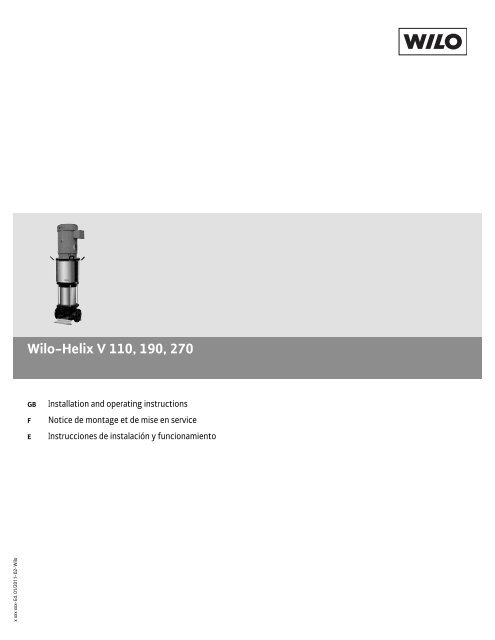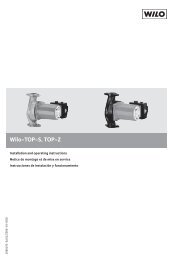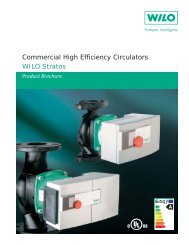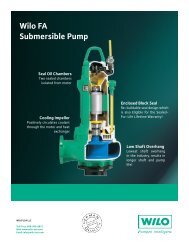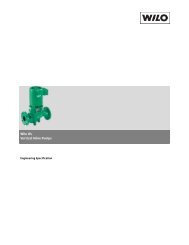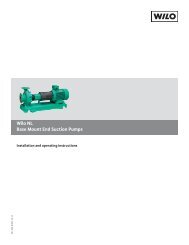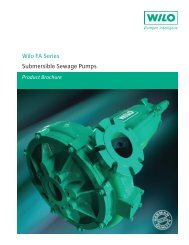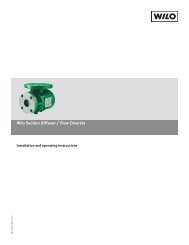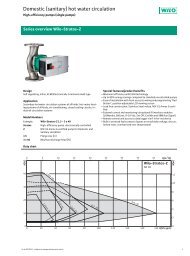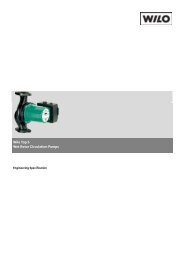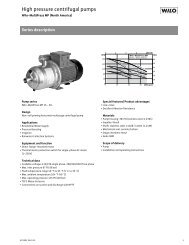Wilo-Helix V 110, 190, 270 - Wilo Canada Inc.
Wilo-Helix V 110, 190, 270 - Wilo Canada Inc.
Wilo-Helix V 110, 190, 270 - Wilo Canada Inc.
You also want an ePaper? Increase the reach of your titles
YUMPU automatically turns print PDFs into web optimized ePapers that Google loves.
<strong>Wilo</strong>-<strong>Helix</strong> V <strong>110</strong>, <strong>190</strong>, <strong>270</strong>GBFEInstallation and operating instructionsNotice de montage et de mise en serviceInstrucciones de instalación y funcionamientox xxx xxx-Ed. 01/2011-02-<strong>Wilo</strong>
Fig. 2:
Table of contentspage1 General ................................................................................................................................................................................................................. 32 Safety.................................................................................................................................................................................................................... 33 Transport and interim storage .......................................................................................................................................................................... 44 Application........................................................................................................................................................................................................... 45 Technical data ..................................................................................................................................................................................................... 56 Description and function ................................................................................................................................................................................... 57 Installation and electrical connection.............................................................................................................................................................. 68 Start up ................................................................................................................................................................................................................. 79 Maintenance / Service ........................................................................................................................................................................................ 810 Faults, causes and remedies ......................................................................................................................................................................... 911 Spare parts ........................................................................................................................................................................................................... 9Table des matièrespage1 Généralités ......................................................................................................................................................................................................... 102 Sécurité............................................................................................................................................................................................................... 103 Transport et stockage ..................................................................................................................................................................................... 124 Application......................................................................................................................................................................................................... 125 Données techniques......................................................................................................................................................................................... 136 Description et fonctionnement ...................................................................................................................................................................... 137 Installation et raccordement électrique ........................................................................................................................................................ 148 Démarrage.......................................................................................................................................................................................................... 159 Entretien et réparation..................................................................................................................................................................................... 1610 Défauts, causes et mesures de dépannage................................................................................................................................................... 1711 Pièces de rechange ........................................................................................................................................................................................... 17Contenidopágina1 Generalidades .................................................................................................................................................................................................... 182 Seguridad ........................................................................................................................................................................................................... 183 Transporte y almacenaje.................................................................................................................................................................................. 194 Aplicación........................................................................................................................................................................................................... 195 Datos técnicos................................................................................................................................................................................................... 206 Descripción y funcionamiento ........................................................................................................................................................................ 207 Instalación y conexión eléctrica...................................................................................................................................................................... 218 Puesta en marcha.............................................................................................................................................................................................. 229 Mantenimiento / Reparación........................................................................................................................................................................... 2310 Averías, causas y soluciones............................................................................................................................................................................ 2411 Repuestos .......................................................................................................................................................................................................... 24
English1 GeneralAbout this documentThese installation and operating instructions are anintegral part of the product. They must be keptreadily available at the place where the product isinstalled. Strict adherence to these instructions is aprecondition for the proper use and correct operationof the product.These installation and operating instructions correspondto the relevant version of the product and theunderlying safety standards valid at the time ofgoing to print.EC declaration of conformity:A copy of the EC declaration of conformity is a componentof these operating instructions.If a technical modification is made on the designsnamed there without our agreement, this declarationloses its validity.2 SafetyThese operating instructions contain basic informationwhich must be adhered to during installationand operation. For this reason, these operatinginstructions must, without fail, be read by the servicetechnician and the responsible operator beforeinstallation and commissioning.It is not only the general safety instructions listedunder the main point "safety" that must be adheredto but also the special safety instructions with dangersymbols included under the following mainpoints.2.1 Indication of instructions in the operatinginstructionsSymbols:General danger symbolHazards from electrical causesNOTE:...Signal words:DANGER!Imminently hazardous situation.Will result in death or seri ous injury if not avoided.WARNING!Risk of (serious) injury. 'Warning' implies that failureto comply with the safety instructions is likelyto result in (severe) personal injury.CAUTION!Risk of damage to the pump/installation. 'Caution'refers to potential product damage if thisinformation is disregarded.NOTE:USEFUL INFORMATION ON THE HANDLING OF THEPRODUCT. IT ATTENDS THE USER TO POSSIBLEPROBLEMS.2.2 Personnel qualificationThe personnel installing the pump must have theappropriate qualification for this work.2.3 Risks incurred by failure to comply with the safetyinstructionsFailure to comply with the safety instructions couldresult in personal injury or damage to the pump orinstallation. Failure to comply with the safetyinstructions could also invalidate any claim for damages.In particular, failure to comply with these safetyinstructions could give rise, for example, to the followingrisks:• Failure of important pump or installation functions,• Failure of specified maintenance and repair methods,• Personal injury due to electrical, mechanical andbacteriological causes,• Damage to property.2.4 Safety precautions for the operatorThe relevant accident precaution regulations mustbe observed. Dangers caused by electrical energymust be excluded. Local or general regulations [e.g.NEC, IEC, VDE, etc.] and directives from local electricalsupply companies are to be followed.2.5 Safety precautions for in spection and installationThe operator must ensure that all inspection andinstallation work is carried out by authorized andqualified specialists who have carefully studiedthese instructions.Work on the pump/unit must be carried out only withthe pump disconnected (locked out) from the electricalsupply and at complete standstill.Installation and operating instructions <strong>Wilo</strong>-<strong>Helix</strong> V<strong>110</strong>, <strong>190</strong>, <strong>270</strong> 6
English2.6 Unauthorized alterations and manufacture ofspare partsAlterations to the pump or installation may only bemade in agreement with the manufacturer. The useof original spare parts and accessories authorized bythe manufacturer will ensure safety. The use of anyother parts may invalidate claims revoking the liabilityof the manufacturer.2.7 Improper useThe operationg safety of the pump or installationsupplied can only be guaranteed if it is used in accordancewith paragraph 4 of the operating instructions.All values must neither exceed nor fall belowthe limit values given in the catalogue or data sheet.3 Transport and interim storageWhen receiving the material, check that there hasbeen no damage during the transport. If shippingdamage has occurred, take all necessary steps withthe carrier within the allowed time.4 ApplicationTypical applications for the <strong>Helix</strong> pumps are cleanfluids relatively free of abrasive particles in commercial,agricultural, industrial and municipal areas.Water supply, water towers, irrigation, high pressurewash down, boiler feed, condensate return and pressureboosting stations. The manufacturer's approvalis required for use to pump for applications not listedabove.DANGER! Risk of explosion!Do not use this pump to handle flammable orexplosive liquidsApplication areas:• water distribution and boosting installations• industrial circulation systems• process fluids• cooling water circuits• washing stations• watering installations, etc.CAUTION! Outside influences may cause damages!If the delivered material is to be installed later on,store it in a dry place and protect it from impactsand any outside influences (humidity, frost etc.).Handle the pump carefully so as not to damage theunit prior to installation.7 WILO SE 02/2011
English5 Technical data5.1 Pump designationType key for pump with motorExample: <strong>Helix</strong> V<strong>110</strong>-02/2-X/A3<strong>Helix</strong> VPump family<strong>110</strong> nominal flow in GPM at 60Hz / 2 poles02 Total number of impellers2 Number of reduced impellersX 1 = stainless steel 3042 = stainless steel 316L3 = pump casing cast iron cataphoresiscoated volute, 304 stainless steel hydraulicA3ANSI Flange 300 lb5.2 Data tableMaximum operating pressurePump casing ANSI flanges 300 lb: 360 PSI (25 bar)Maximum suction 140 PSI (10 bar)pressureTemperature rangeLiquid temperatures -4 °F to 250 °F(- 20° to + 120 °C)Ambient temperature +104 °F Max (+ 40 °C)Electrical dataMotor efficiency EISA 2011 CompliantMotor Enclosure TEFCInsulation class FFrequencySee motor platingElectrical voltageOutline and pipe dimensions (see: Fig. 4)TypeDimensions (inch) – standard configurationA B C D E F G H<strong>Helix</strong> V<strong>110</strong>-01 — V<strong>110</strong>-09 5-1/8 11-7/8 8-1/2 10 11-7/8 3-1/2 2 8 x M16<strong>Helix</strong> V<strong>190</strong>-01/1 — V<strong>190</strong>-07/2 6-11/16 11-7/8 9-7/16 10 12-5/8 4-1/8 2-1/2 8 x M16<strong>Helix</strong> V<strong>270</strong>-01/1 — V<strong>270</strong>-06/2 7-1/2 11-7/8 10-1/2 10 14-3/8 5-1/2 3 8 x M165.3 Scope of SupplyInstallation and operating instructions5.4 AccessoriesPlease contact your WILO sales office for accessorieslist.6 Description and function6.1 Product descriptionsee Fig. 11 Motor bolt2 Coupling guard3 Cartridge seal4 Hydraulic stage casing5 Impeller6 Pump shaft7 Motor8 Coupling9 Motor Stool10 Tube liner11 Flange12 Pump housing13 Base plateSee fig.2 and 3:1 Strainer2 Pump suction valve3 Pump discharge valve4 Check valve5 Drain + priming plug6 Air bleed screw + Filling plug7 Tank8 Foundation6.2 Design of product• HELIX V<strong>110</strong>, V<strong>190</strong> and V<strong>270</strong> are vertical multistage,high pressure, non-self priming, inline pressureboosting pumps.• HELIX pumps combine use of both high efficiencyhydraulics and motors.• All metallic parts in contact with water are made ofstainless steel or grey cast iron.• For aggressive fluid, special versions exist with 100% stainless steel of all wetted components.• A cartridge seal is used as standard for all HELIXrange in order to ease maintenance.• In addition, for 7 ½ Hp and above, a spacer couplingallows to change this seal without removing themotor.• HELIX motor stool design integrates an additionalball bearing to absorb downthrust, eliminatingmotor bearing.• Special handling devices are integrated in order tofacilitate pump installation.Installation and operating instructions <strong>Wilo</strong>-<strong>Helix</strong> V<strong>110</strong>, <strong>190</strong>, <strong>270</strong> 8
English7 Installation and electrical connectionInstallation and electrical work only in compliancewith any local codes and by qualified personnel!WARNING! Bodily injury!Existing regulations for the prevention of accidentsmust be observed.WARNING! Electrical shock hazardDangers caused by electrical energy must beexcluded.• Electrical work by a qualified electrician only!• National Electrical Codes, local codes and regulationsmust be strictly followed.• All electrical connections must be performedafter the electrical supply has been switched offand secured against unauthorized switching.• For safe installation and operation a propergrounding of the pump to the power supply’sgrounding terminals is required.7.1 Commissioning• Unpack the pump and dispose of the packaging in anenvironmentally-responsible manner.7.2 InstallationThe pump must be installed in a dry, well-ventilatedand frost-free place.CAUTION! Possible damage of the pump!Dirt and solder in the pumps hydraulic can affectthe pump operation.It is recommended that any welding and solderingwork be done before installing the pump.Thoroughly flush the system out before installingthe pump.• The pump must be installed in an easily accessibleposition to facilitate inspection or replacement.WARNING! Risk of accident by hot surfaces!The pump must be positioned to eliminate contactwith the hot pump surfaces while in operation.• Install the pump in a dry place protected from frost,on a flat concrete block using appropriate screws. Ifpossible, use an insulating material under the concreteblock (cork or reinforced rubber) to avoid anynoise and vibration transmission into the installation.WARNING! Risk of pump displacement!The pump must be secured to the ground.• Place the pump where it will be easially accessable,to facilitate inspection and removal work. The pumpmust be installed perfectly upright on a sufficientlyheavy concrete base.CAUTION! Risk of parts inside the pump!Take care to remove pump flange covers prior toinstallation.NOTE:Each pump could be tested to confirm hydraulic performancein the factory, consequently some testingfluid could still be present inside the pump. It is recommendedfor hygienic purposes, to flush the pumpinternals before any using with potable water supply.• The installation and connection dimensions aregiven §5.2• Lift the pump carefully by using the integrated rings,if necessary with a hoist and suitable slings accordingto the current hoist guidelines.WARNING! Risk of fall!Take care to pump lifting lugs especially for thehighest pumps whose centre of gravity couldcause the pump/motor assembly to fall over.WARNING! Risk of fall!Take care to pump lifting lugs especially for thehighest pumps whose centre of gravity couldcause the pump/motor assembly to fall over.7.3 Pipe connection• Connect the pump to the piping system withflanges, nuts, bolts and gaskets supplied by others.CAUTION!Tightening of bolts must not exceed 74 ft.-lbs.Use of impact wrench is prohibited.• The flow direction of the fluid is indicated on theidentification label of the pump.• Pump must be installed in such a way that it is notstressed by the pipework. The pipes must beattached so that the pump does not bear theirweight.• It is recommended that isolation valves be installedon the suction and discharge side of the pump.• Use of expansion joints may reduce noise and vibrationof the pump.• The inlet pipe diameter should not be less than theflange pipe size.• A check valve could be placed on the discharge pipein order to protect the pump against water hammer(hydraulic shock).9 WILO SE 02/2011
English• For direct connection to a public drinking water system,the suction pipe must also have a check valve(or backflow prevention device) and an isolationvalve.• For indirect connection via a tank, the suction pipemust have a strainer to keep any impurities out ofthe pump and a check valve.7.4 Motor connection for bare-shaft pump (withoutmotor)• Remove coupling guards.NOTE:Coupling guards can be removed without entirelyunscrewing screws.• Install the motor on the pump by using screws (FTlantern size – see product designation) or bolts, nutsand handling devices (FF lantern size – see productdesignation) provided with the pump : check motorpower and dimension in WILO catalogue.NOTE:Depending on fluid characteristics, motor powermight be modified. Contact WILO Customer Servicesif needed.• Close the coupling guards by screwing all screwsprovided with the pump.7.5 Electrical connectionWARNING! Electrical shock hazardDangers caused by electrical energy must beexcluded.• Electrical work by a qualified electrician only!• National Electrical Codes, local codes and regulationsmust be strictly followed.• All electrical connections must be performedafter the electrical supply has been switched offand secured against unauthorized switching.• For safe installation and operation a propergrounding of the pump to the power supply’sgrounding terminals is required.• Check that operating current, voltage and frequencyused comply with motor nameplate data.• The pump must be connected to the power supplyby a solid cable equipped with a grounded plug-connectionor a main power switch per local electricalcodes.• Three-Phase motors must be connected to anapproved safety switch (motor starter). The setnominal current must correspond to the electricaldata on the motor name plate• The electrical cable must be positioned so that itnever touches the pipework and/or the pump andmotor housing.• The pump/installation should be grounded in compliancewith local regulations. A ground fault interrupter(GFI) can be used as extra protection.• The connection to the power supply must be inaccordance with the wiring diagram (see Fig. 4).7.6 Operation with frequency converter• Motors used can be connected to a frequency converterin order to adapt pump performance to dutypoint.• The converter must not generate voltage peaks atmotor terminals higher than 850V and dU/dt slopehigher than 2500 V/μs.• In case of higher value, an appropriate filter must beused : contact converter manufacturer for this filterdefinition and selection.• Strictly follow instructions provided by the convertermanufacturer data sheet for installation.• Minimum variable speed should not be set below40% of pump nominal speed.8 Start up8.1 System filling - VentingCAUTION! Possible damage of the pumpNever operate the pump dry.The system must be filled before starting thepump.8.1.1 Air venting process – Pump with positive supplypressure (see fig.3) :• Close the two isolation valves [2 + 3].• Unscrew the air bleed screw from filling plug [6a].• Slowly open the isolation valve on the suction side[2].• Retighten the air-bleed screw once the air has beenremoved (fluid evacuates from the air-bleed screw)[6a].WARNING! Risk of scaldingWhen the pumped liquid is hot and the pressurehigh, the fluid escaping at the air bleed screw maycause burns or other injuries.• Open the isolation valve on the suction side completely[2].• Start the pump and check if direction of rotationmatches the direction arrow on the pump.CAUTION! Possible damage of the pumpReverse rotation will cause reduced pump performanceand possible coupling and pump damage.• Open the isolation valve on the discharge side [3].Installation and operating instructions <strong>Wilo</strong>-<strong>Helix</strong> V<strong>110</strong>, <strong>190</strong>, <strong>270</strong> 10
English10 Faults, causes and remediesWARNING! Electrical shock hazardDangers caused by electrical energy must beavoided.All electrical work must be performed after theelectrical supply has been switched off andsecured against unauthorized operation.WARNING! Risk of scaldingAt high water temperatures and system pressureclose both isolating valves before and after thepump.First, allow pump to cool down.FAULT CAUSES REMEDYPUMP FAILS TO OPERATE• No current• Check the fuses, the wiring and the connectors.• Eliminate any causes of motor overloads.• The thermistor tropping devicehas tripped out, cutting off powerPUMP RUNS BUT DOES NOT PROVIDESUFFICIENT FLOW OR PRESSURE• Reverse rotation• Parts of the suction pipe areobstructed by foreign material• Air in suction pipe• Suction pipe too small• Valve(s) are not open far enoughIf the fault cannot be solved, please contact WILOcustomer service.• Check the direction of rotation of the motor andcorrect it if necessary.• Check and clean the pipe.• Make the suction pipe airtight.• Install a larger suction pipe.• Open the valve properly.PUMP FLOW SURGES • Air in pump • Evacuate the air in the pump; check that thesuction pipe is airtight. If required, run the pumpfor 20-30sec – open the air bleed screw in orderto remove air – close the air bleed screw andrepeat it several times until no air is escaping outof the pump.PUMP VIBRATES OR IS NOISY• Foreign material in pump• Pump not properly mounted to thefloor• Bearing damaged• A phase is an open-circuit• Ambient temperature too high• Remove the foreign material.• Retighten the screws.• Call WILO Customer Service.MOTOR OVERHEATS –OVERLOAD PROTECTION TRIPS• Check fuses, wiring, and the connectors.• Provide cooling.MECHANICAL SEAL IS LEAKING • Mechanical seal is damaged • Replace the mechanical seal.11 Spare partsAll spare parts must be ordered through WILO CustomerService.In order to avoid any order errors, please specify thename plate data for orders.Spare parts catalogue is available at www.wilousa.com.Installation and operating instructions <strong>Wilo</strong>-<strong>Helix</strong> V<strong>110</strong>, <strong>190</strong>, <strong>270</strong> 12


